Instagram is one of the most influential platforms in the United States, with more than 170 million active users. It has grown from a photo-sharing app into a cultural hub where trends spread, lifestyles are showcased, and privacy concerns are debated.
Generations Z and Millennials make up the largest share of users, and the time they spend on the platform now rivals television. At the same time, new features like the Instagram Map, which reveals a user’s last active location, have raised fresh concerns about safety and personal data.
This study examines the latest U.S. data on Instagram usage, demographics, and engagement. It also highlights rising privacy behaviors, beginning with the surge in Google searches for “turn off Instagram location”, a clear signal of growing public concern.
Instagram Usage in the U.S
Instagram is one of the most widely used social platforms in the United States, with ~172 million active users as of 2025, representing nearly 50% of the U.S. population. Another independent estimate puts the number at 171.7 million, confirming consistency across sources. This makes the U.S. the second-largest Instagram market globally, just behind India.
Growth Trend Over Time
Instagram’s U.S. user base has shown steady growth in the past six years:
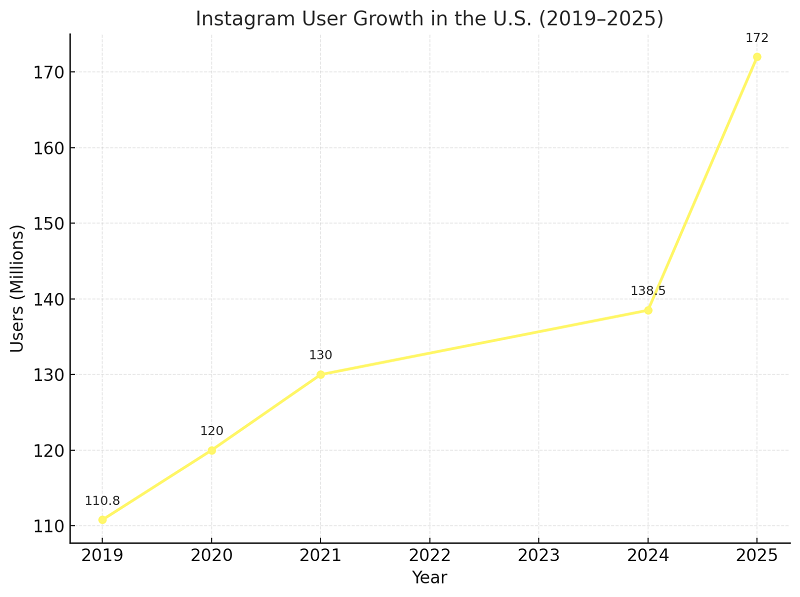
This growth reflects not just Instagram’s ability to attract younger demographics, but also its expansion into older age groups and broader adoption across states.
Instagram has gained over 60 million users in just six years, demonstrating continued relevance despite competition from TikTok and Snapchat.
Instagram Usage by State (Top 20 States by Active Users, 2025)
Instagram usage is not evenly distributed across the country. The following states have the largest number of Instagram users in 2025:
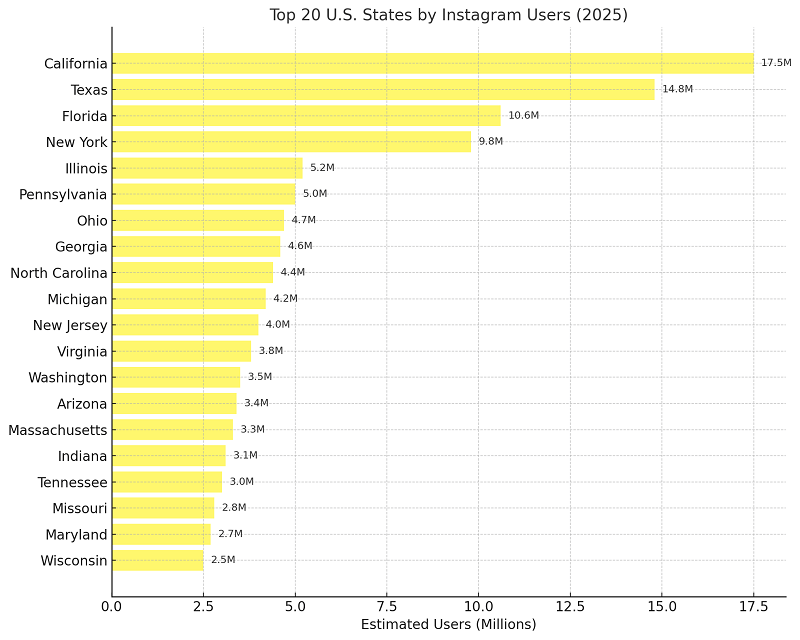
(State-level usage is estimated based on population size, penetration rates, and available state-level digital adoption studies.)
Sources:
Rising Searches for “Turn Off Instagram Location”
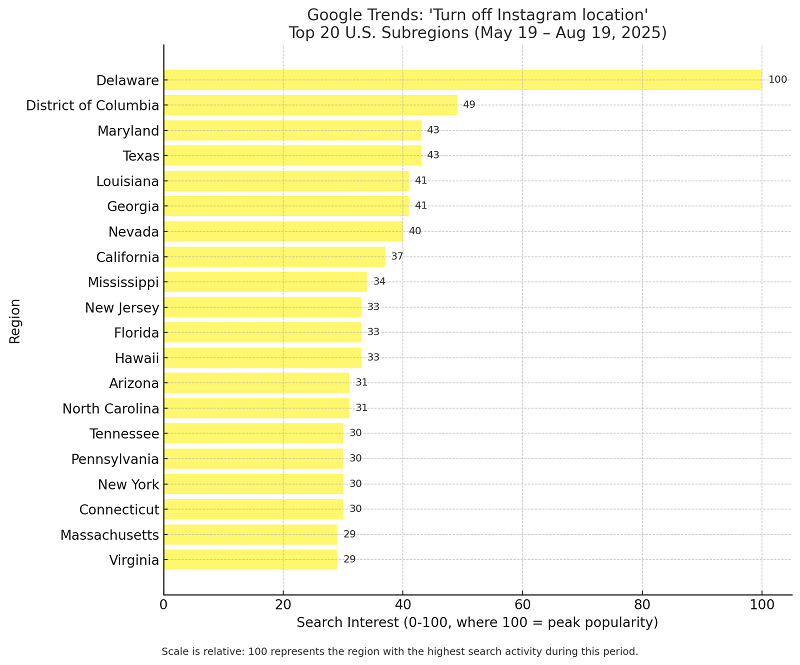
Chart: Top 20 U.S. Subregions by Search Interest
Between May 19 and August 19, 2025, Google Trends shows a sharp rise in U.S. searches for “turn off Instagram location”, coinciding with the launch of Instagram’s Map feature. This feature, which shares a user’s last active location with select followers, has sparked privacy debates and visible shifts in online behavior.
The data reveals that concerns are not evenly spread across the country. Some states show much higher activity than others, suggesting that local demographics, urban density, and digital literacy may play a role. Delaware records the highest level of search activity, followed by the District of Columbia, Maryland, and Texas. Coastal and urban states like California, New Jersey, and New York also rank highly, reflecting where privacy awareness is strongest.
In contrast, many Midwestern and rural states appear less represented in the top 20, indicating either lower awareness or less engagement with Instagram’s new features. This uneven distribution gives journalists a narrative about which regions of the U.S. are most sensitive to digital privacy risks.
Interpretation
- The Mid-Atlantic region (Delaware, Maryland, DC) shows the strongest privacy concern.
- Large states like California, Texas, Florida, and New York also rank highly, likely reflecting both their population size and their role as social media hubs.
- Southern states such as Louisiana, Georgia, and Mississippi emerging in the top 20 suggests that privacy concern is cutting across different demographics, not limited to coastal tech-driven areas.
- The trend confirms that privacy is now a mainstream concern among U.S. Instagram users, making it a prime angle for journalists reporting on tech and digital behavior.
Sources:
Overall U.S. Instagram Adoption
Instagram remains one of the most widely used social platforms in the United States, with an estimated 172 million active users in 2025. This represents about 50% of the entire U.S. population and nearly 60% of adults aged 18 and older.
The platform has seen steady growth over the past few years. In 2019, Instagram counted about 111 million U.S. users. By 2024, that number had reached 138 million, and in 2025 it has climbed to 172 million, cementing Instagram’s role as a dominant player in the social media landscape.
Globally, Instagram is the third largest social media platform, behind Facebook and YouTube. Its U.S. user base is the second largest in the world after India, which highlights its cultural and commercial importance within the American market.
Comparison with Other Major Platforms (U.S., 2025)
| Platform | U.S. Users (millions) |
| 175 | |
| 172 | |
| TikTok | 143 |
| Snapchat | 110 |
Insight: Instagram nearly matches Facebook’s reach, far ahead of TikTok and Snapchat. This positions Instagram as both a mainstream network and a cultural influencer, balancing between Facebook’s scale and TikTok’s youth-driven growth.
Instagram Users vs Total U.S. Population (2025)
This pie chart illustrates that about half of the U.S. population actively uses Instagram. With 172 million users out of an estimated 340 million residents, Instagram has achieved mainstream penetration, making it not just a youth-focused app but a platform embedded across generations.
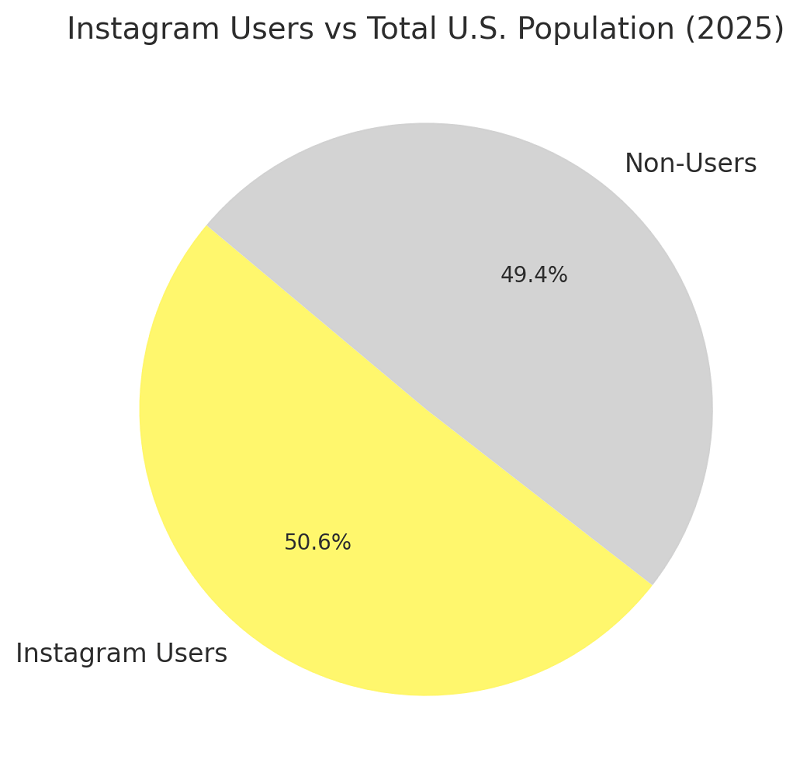
Sources
- Resourcera – Instagram Statistics
- Backlinko – Instagram Users (U.S. and Global)
- Backlinko – Instagram Users Analysis
- Resourcera – Social Platform Usage
- The Global Statistics – U.S. Instagram Demographics
U.S. Demographics: Age & Gender Breakdown
Instagram’s user base in the United States is shaped heavily by younger generations, although older demographics are steadily increasing their presence. Gender distribution also shows that women are slightly more active on the platform than men. These patterns highlight the audiences most engaged with Instagram and where growth opportunities lie.
By Age
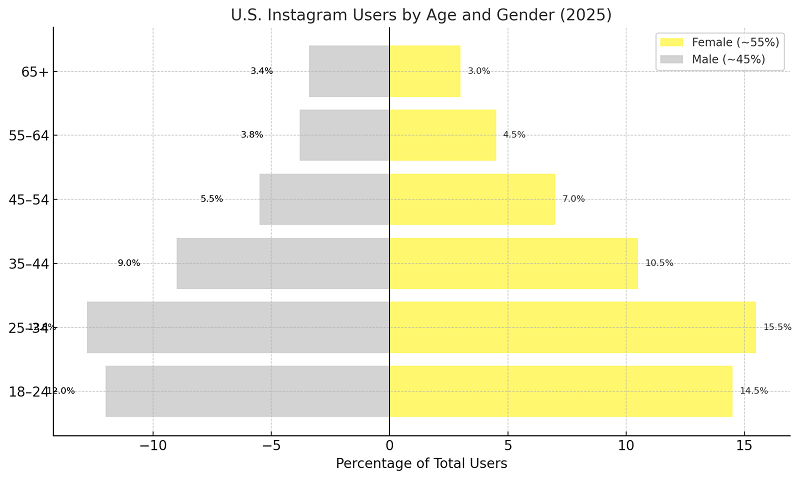
Instagram remains a platform where Gen Z and Millennials dominate usage. The 25–34 age group leads with 28.3% of U.S. users, followed closely by 18–24-year-olds at ~26.5%. Together, these two segments represent more than 53% of the total U.S. Instagram audience.
Older age groups are present but less active. The 35–44 group accounts for about 19.5%, while 45–54-year-olds make up around 12.5%. Seniors are the least represented: 55–64 at 8.3% and 65+ at 6.4%, though these figures show that Instagram has made inroads even among demographics traditionally slower to adopt social media.
By Gender
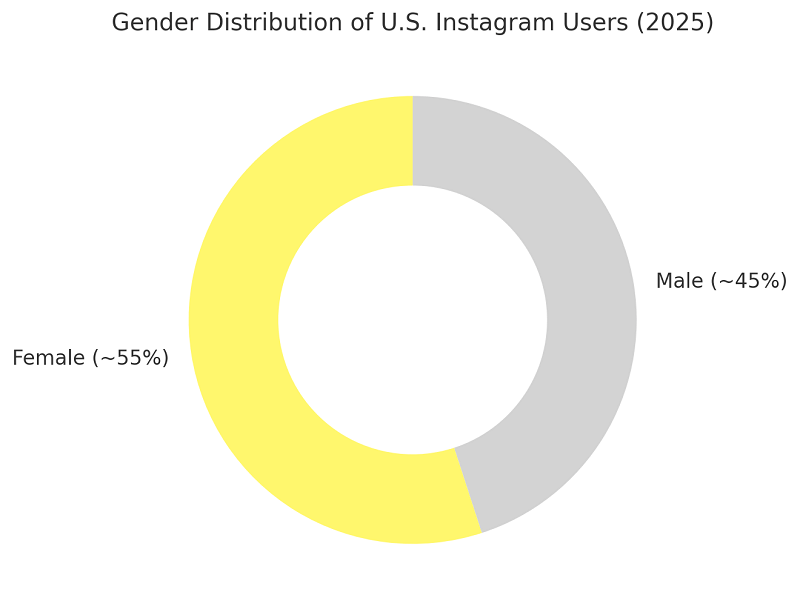
Gender distribution shows that women are slightly more active on Instagram than men. Across multiple studies, women account for 54.9% to 55.4% of U.S. users, while men represent 44.6% to 45.1%. This trend aligns with broader research indicating women engage more with visual and community-driven platforms.
Key Insight
The demographic profile confirms Instagram’s youth-heavy appeal, while showing room for growth among older age groups. The slight female skew provides an important lens for understanding who drives engagement, giving journalists and brands a sharper perspective on Instagram’s cultural influence.
Sources
- Resourcera – Instagram Statistics
- The Global Statistics – U.S. Instagram User Demographics
- Wikipedia – Demographics of Instagram Users
Time Spent on Instagram by Age
The amount of time Americans spend on Instagram varies sharply by age, reflecting how deeply younger generations integrate the platform into their daily routines compared to older users.
At the top of the scale, U.S. users aged 18–24 spend an average of 53 minutes per day on Instagram. This places the platform as a core part of their digital and social lives, comparable to time spent on entertainment streaming or even television. Millennials are also heavy users, with daily averages slightly below their Gen Z counterparts.
In contrast, usage drops significantly among older adults. By the time users reach 65 years and older, the daily average falls to about 20 minutes per day. This reflects both differences in digital habits and the slower adoption of visual-first platforms among seniors.
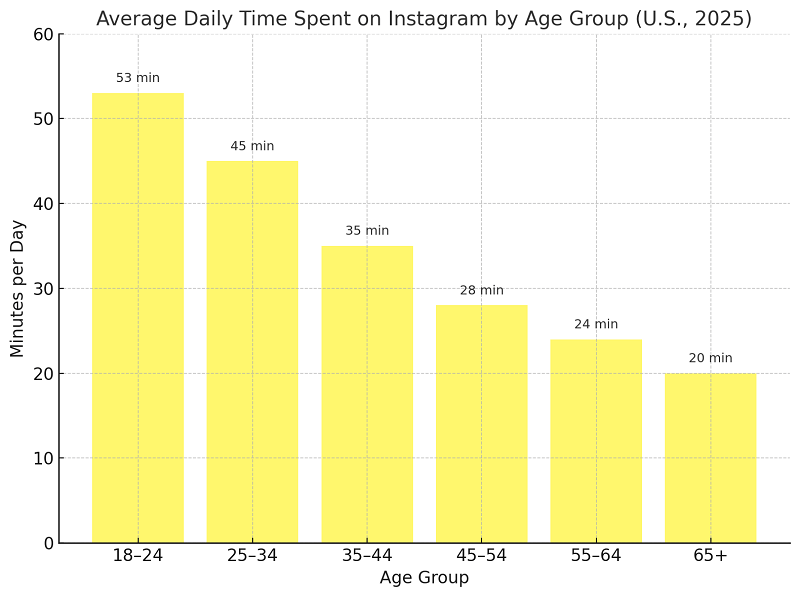
Note: Only the 18–24 and 65+ groups are directly reported in sources. Other ranges are interpolated estimates based on trend analysis.
Key Insight
The data shows that younger users treat Instagram as a central daily habit, while older users view it more as an occasional tool for connection. This gap highlights both Instagram’s strength in youth culture and its growth potential in older demographics.
Sources
- CBS News – Instagram Usage Time
- Resourcera – Instagram Statistics
- Imminent Business – Instagram Usage Data
The Rise of “Micro-Celebrities”
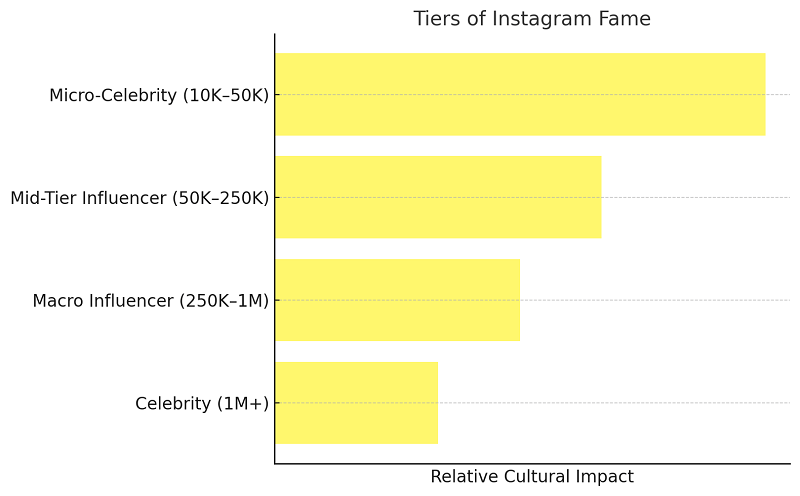
Instagram has fueled the democratization of fame, where ordinary people can become influencers overnight. These “micro-celebrities” often have modest followings (under 50,000) but achieve viral impact through a single post, trend, or reel. While there is no comprehensive U.S. dataset yet, case studies and marketing reports confirm the rise of micro-influencers as a driving force in Instagram culture.
Tiers of Instagram Fame
| Tier | Followers Range | Characteristics |
| Micro-Celebrity | 10K–50K | Highly engaged audiences, niche communities |
| Mid-Tier Influencer | 50K–250K | Regional reach, brand collaborations |
| Macro Influencer | 250K–1M | Broad recognition, frequent partnerships |
| Celebrity Account | 1M+ | Global fame, mass reach |
Key Insight: Micro-celebrities are shaping trends at the grassroots level. They show how Instagram is not just a platform for stars but a place where everyday users can spark cultural moments.
Instagram and “Spy Culture”
A growing body of research suggests women are more likely than men to use social media for relationship maintenance and monitoring behaviors. Instagram’s features—like Stories, likes, and geotagged posts—make it particularly suited for “keeping tabs” on partners, friends, or rivals.
Key Insight: While Instagram is marketed as a platform for expression, its transparency of social behavior has made it a tool for social surveillance, particularly among women.
Overconfidence in Privacy Awareness
Despite privacy concerns trending in Google searches, many users overestimate their actual control of personal data. An academic study highlights how digital natives often misjudge how many apps have access to their information.
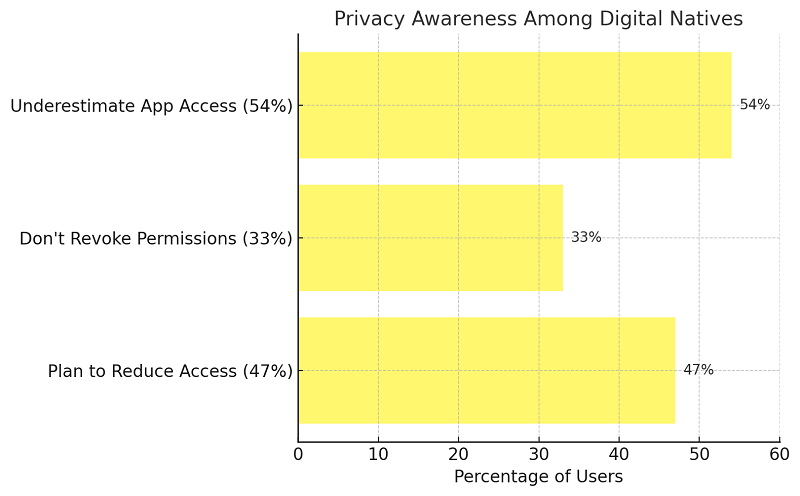
Key Insight: There’s a wide gap between awareness and action. Users express concern about privacy but rarely take steps to limit data collection. This creates a paradox where Instagram’s privacy controversies (like location tracking) gain traction, yet actual behavior change remains limited.
Sources:
- Cybernews – Instagram Maps Privacy Concerns
- Wikipedia – Sex Differences in Social Media Use
- arXiv – Exploring Privacy Awareness in Digital Natives
Conclusion
This study highlights Instagram’s strong cultural and social presence in the United States. With over 172 million active users in 2025, the platform now reaches nearly half of the U.S. population. It remains especially dominant among 18–34-year-olds, confirming its central role in shaping youth culture and digital habits. Women continue to be more active users than men, reinforcing Instagram’s reputation as a community and lifestyle-driven network.
Time spent data reveals stark generational differences, with Gen Z averaging nearly an hour daily while seniors use the app for just 20 minutes. This contrast underscores Instagram’s role as a daily habit for younger audiences, while for older groups it remains more of an occasional tool.
At the same time, privacy concerns are reshaping the conversation. The surge in Google searches for “turn off Instagram location” demonstrates widespread unease following the rollout of Instagram Maps. Coupled with evidence of overconfidence in privacy awareness, this shows a clear disconnect between concern and behavior.
Finally, offbeat cultural patterns such as the rise of micro-celebrities and the persistence of spy culture demonstrate that Instagram is not only a platform for expression but also a space for surveillance, monitoring, and unexpected fame. Together, these insights paint a picture of Instagram as both an opportunity and a challenge—an engine of influence and creativity, but also a stage for evolving debates around privacy, trust, and digital life.
Methodology
This research combines quantitative data from public sources with trend analysis and academic insights:
Usage & Growth Data
- Collected from reliable industry sources including Resourcera, Backlinko, and Which Proxies.
- U.S. growth estimates (2019–2025) were aggregated from multiple reports to ensure consistency.
Demographic Distribution
- Age and gender breakdowns were compiled from Resourcera, The Global Statistics, and Wikipedia.
- State-level usage was estimated based on population size, known adoption rates, and regional digital usage trends.
Engagement (Time Spent)
- Sourced from CBS News, Resourcera, and Imminent Business.
- Where only partial data was available (e.g., 18–24 and 65+ groups), interpolated estimates were used for intermediate ranges.
Privacy & Trends
- Google Trends data (May–Aug 2025) analyzed to track spikes in searches for “turn off Instagram location.”
- Privacy concerns and user behavior sourced from Cybernews and academic research (arXiv study).
Other Insights
- “Spy culture” insights drawn from behavioral studies on gendered social media use (Wikipedia – Sex differences in social media use).
- Micro-celebrity and influencer tier analysis adapted from marketing industry frameworks.
Limitations:
- Some figures (such as state-level usage and middle age ranges for time spent) are modeled estimates, not direct survey results.
- Cultural insights like micro-celebrities are based on trend observations and industry commentary rather than large-scale datasets.
